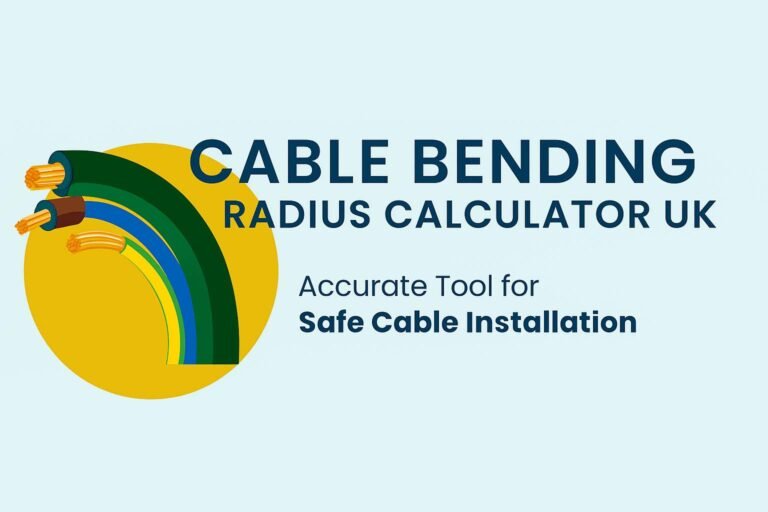HV Cable Bending Radius Calculator – Accurate Tool for Safe Cable Installation
When installing high-voltage cables, maintaining the correct bending radius is critical. Improper bending can damage insulation, weaken the conductor, and reduce the cable’s life span. That’s where an HV cable bending radius calculator becomes essential. This tool helps electrical engineers, installers, and technicians quickly determine the minimum safe bend radius for various types of high-voltage (HV) cables. Understanding how to calculate and apply these values ensures safe, compliant, and efficient installations for any voltage level or cable type.

Table of Contents
What is an HV Cable Bending Radius Calculator
An HV cable bending radius calculator is an online or software-based tool that determines how tightly a high-voltage cable can be bent during installation without causing damage. The calculator uses key parameters such as cable diameter, construction type (single-core or three-core), insulation type, and manufacturer specifications. It provides the minimum bending radius in millimeters or meters, helping installers avoid overstressing the cable. Use our online tool 3 phase cable size calculator
For example, bending a 33kV or 66kV cable too sharply can lead to internal cracking of insulation or conductor deformation. The calculator eliminates guesswork and ensures every bend complies with IEC, BS, or NEC standards.
HV Cable Bending Radius Calculator
HV Cable Bending Radius Calculator
HV construction-aware radius rules with manufacturer override, plus bend geometry (arc/chord) and compliance checks.
Cable & installation parameters
Geometry & hardware
– Enter the cable’s overall diameter from the HV cable datasheet. Select the construction and installation condition to apply appropriate bending factors.
– If the datasheet specifies a minimum bend radius (e.g., “≥ 15×D” or a fixed mm value), enter it via the “Custom k” field or treat the fixed radius as your proposed radius and check compliance.
– Optionally enter a proposed radius and any mandrel/roller diameter to run compliance checks against the computed minimum radius.
– Set a bend angle (e.g., 45°, 90°) and optional segments. Click “Calculate” to see minimum radius/diameter, PASS/FAIL, and bend geometry (arc/chord, developed length).
– Use outputs to plan routing, spacing, and hardware selection. When uncertain, pick the more conservative (larger) radius.
HV cable bending limits are strongly dependent on construction (screens, metallic sheath, armour), temperature, installation method, and manufacturer specification. Always defer to the cable’s datasheet; when in doubt, use a higher factor.
Importance of Bending Radius in HV Cable Installation
The bending radius of an HV cable directly affects its electrical and mechanical integrity. A radius that is too small can cause the following issues:
- Insulation cracking or tearing due to excessive stress
- Sheath deformation and reduced dielectric strength
- Conductor damage leading to higher resistance and heat buildup
- Cable joint failure and reduced lifespan
When laying cables in trenches, ducts, or trays, it’s vital to maintain the correct bending radius to ensure smooth current flow and long-term reliability. The HV cable bending radius calculator helps maintain these standards easily. Try our free online tool today ev charger cable size calculator
Factors Affecting HV Cable Bending Radius
Several factors influence the bending radius of an HV cable:
- Cable Diameter: Larger diameter cables require a greater bending radius.
- Voltage Rating: Higher voltage cables have thicker insulation, which increases rigidity.
- Conductor Type: Stranded conductors are more flexible than solid ones.
- Cable Construction: Single-core and three-core cables have different bending characteristics.
- Installation Condition: Whether the cable is bent during or after installation matters. Cold bending requires larger radii than warm bending.
Typical Minimum Bending Radius Standards
Standards such as IEC 60502, BS 6622, and ICEA provide guidelines for minimum bending radii. Below is a general table showing typical values for high-voltage cables.
| Cable Type | Minimum Bending Radius (During Installation) | Minimum Bending Radius (After Installation) |
|---|---|---|
| Single-core, Armoured | 15 × overall diameter | 12 × overall diameter |
| Single-core, Unarmoured | 12 × overall diameter | 10 × overall diameter |
| Three-core, Armoured | 12 × overall diameter | 10 × overall diameter |
| Three-core, Unarmoured | 10 × overall diameter | 8 × overall diameter |
These are general guidelines. The HV cable bending radius calculator allows precise calculation based on actual cable properties rather than relying only on standard estimates. Access our powerful online calculator now star delta motor cable size calculator
How the HV Cable Bending Radius Calculator Works
The calculator operates using a simple formula derived from cable diameter and standard bending ratios.
Formula:
Minimum Bending Radius = Cable Overall Diameter × Bending Factor
The bending factor varies based on cable construction and standard requirements. For example, for a single-core XLPE armoured cable, the factor is typically 15.
Let’s take an example:
- Cable Diameter = 60 mm
- Bending Factor = 15
Minimum Bending Radius = 60 × 15 = 900 mm
Thus, the installer must ensure the cable bend is not tighter than a 900 mm radius. Using an HV cable bending radius calculator makes this process instant and reduces manual errors.
Advantages of Using an HV Cable Bending Radius Calculator
The calculator is not just a convenience tool but a necessity for safe electrical engineering practices. Key advantages include:
- Accuracy: Provides exact bend radius values for specific cable types.
- Time-Saving: Quick calculation without manual reference tables.
- Safety: Prevents cable damage and failure due to improper bending.
- Compliance: Ensures installation meets IEC, BS, and NEC standards.
- Cost Efficiency: Reduces rework, replacement, and system downtime.
HV Cable Bending Radius for Common Voltage Ratings
Different voltage levels require different cable sizes and insulation thicknesses. Below is an approximate reference for typical HV cable sizes and their bending radii.
| Voltage Level | Typical Cable Size | Approx. Diameter (mm) | Typical Bending Radius (mm) |
|---|---|---|---|
| 11kV | 3C × 95mm² | 60 | 600–900 |
| 22kV | 3C × 185mm² | 80 | 800–1200 |
| 33kV | 1C × 300mm² | 65 | 900–1000 |
| 66kV | 1C × 500mm² | 80 | 1200–1600 |
| 132kV | 1C × 800mm² | 100 | 1500–2000 |
These values vary depending on the manufacturer. Always verify the exact specifications using an HV cable bending radius calculator for accuracy. Get instant results with our online tool earth cable size calculator
Installation Tips for Maintaining Correct Bending Radius
When installing high-voltage cables, follow these simple practices to maintain proper bending:
- Avoid forcing cables into tight corners or trenches.
- Use rollers or cable jacks to support the cable during pulling.
- Maintain even tension along the cable during laying.
- Check the bending radius with a calculator before installation.
- For cold environments, increase the minimum bending radius by 20% to prevent insulation cracking.
Proper handling and calculation ensure that the HV system remains reliable and efficient for decades.
Related Concepts and Tools
Besides bending radius, other cable installation parameters are equally important. Tools like cable tray load calculators, current carrying capacity calculators, and voltage drop calculators are used together with the HV cable bending radius calculator. This combination provides a complete design overview for safe and efficient power transmission systems.
Using these online tools together allows engineers to plan route layouts, avoid thermal overload, and maintain safe clearances between cables. Start using our easy-to-use online tool earthing cable size calculator
Real-World Example of Using the Calculator
Consider an electrical engineer installing a 33kV single-core XLPE armoured cable with an overall diameter of 70 mm. According to IEC 60502, the bending factor is 15.
Minimum Bending Radius = 70 × 15 = 1050 mm
Therefore, the minimum allowable bend is 1.05 meters. The calculator instantly provides this value, ensuring the bend at corners or joints remains compliant. If the same cable were unarmoured, the bending factor might drop to 12, reducing the radius to 840 mm. This flexibility helps design teams optimize space and layout without compromising safety.
Common Mistakes to Avoid When Using Bending Radius Values
- Ignoring temperature conditions when applying bending limits
- Using general tables instead of exact cable dimensions
- Bending cables immediately after uncoiling without relaxation time
- Assuming same radius for single-core and multi-core cables
- Overlooking manufacturer’s datasheet recommendations
The HV cable bending radius calculator minimizes these errors by integrating standardized data and real-time computation. Calculate instantly with our smart online tool cable size calculator australia
Why Every Installer Should Use an HV Cable Bending Radius Calculator
High-voltage installations demand precision. Even a minor error in bending can cause long-term reliability issues. The calculator simplifies compliance with safety standards and provides data-backed confidence during project execution. It’s especially valuable in substations, underground cabling, wind farms, and solar grid connections where multiple bends and transitions are required.
Using this calculator also helps design engineers prepare accurate CAD layouts and cable schedules, reducing clashes and ensuring clean installations. Experience fast and accurate results using our online tool cable size calculator uk
Frequently Asked Questions
1. What is the purpose of the HV cable bending radius calculator?
It ensures that cables are not bent beyond their safe mechanical limit, preventing insulation or conductor damage.
2. Can the bending radius be reduced for flexible cables?
Yes, flexible cables often allow smaller radii, but it must still follow the manufacturer’s guidance.
3. Does temperature affect bending radius?
Yes. In cold weather, cables become stiffer and require a larger bending radius.
4. What standard defines bending radius for HV cables?
IEC 60502, BS 6622, and ICEA standards define the minimum bend radius for various cable constructions.
5. Is it necessary to use an online calculator?
While manual calculations are possible, online calculators save time, improve accuracy, and reduce human error.
Conclusion
The HV cable bending radius calculator is a vital engineering tool that enhances safety, efficiency, and reliability in high-voltage installations. It simplifies the process of determining the minimum safe bend for different cable types and voltage ratings. Whether you are installing 11kV or 132kV lines, maintaining the correct bending radius ensures optimal performance and compliance with international standards. Explore our professional online tool for quick calculations kw to cable size calculator
By using the HV cable bending radius calculator before installation, engineers and contractors can prevent costly damages, extend cable lifespan, and achieve smoother, safer power distribution systems.
Follow Us on Social:
Subscribe our Newsletter on Electrical Insights for latest updates from Electrical Engineering Hub
#HVCableBendingRadius, #CableBendingCalculator, #HVCableInstallation, #ElectricalEngineering, #PowerCables, #CableSafety, #HighVoltageCables, #CableManagement, #ElectricalDesign, #CableRadius, #EngineeringTools, #CableBendLimits, #CableCalculator, #ElectricalProjects, #EnergyInfrastructure






